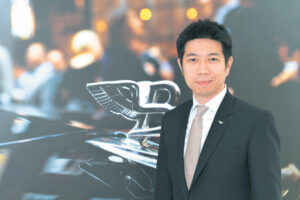The Velocity Q&A: Christopher Chan (PGA Cars Planning Director)

Interview by Kap Maceda Aguila
IT MAY be a little hard to believe, but the first hybrid vehicle formally made its way into the country more than decade ago. And while the idea then of a traditional internal combustion engine supplemented by an electric motor wasn’t really a box-office hit, it surely managed to open some eyes on the long-term practicality — and inevitability — of electric mobility.
That’s what electrification in the mobility sector is: inevitable. Today, most car makers have articulated their desire to be carbon-neutral or to dispense with fossil-fuel-powered engines by a fixed year in a bid not just to adhere to ever-tightening international fuel economy and emissions standards, but to earnestly make a transition to cleaner transportation to assure a healthy, viable planet for those who will come after us.
And what was novel then is certainly more widely accepted now. Electrified vehicles from hybrids to plug-in hybrids to full electrics have made their way into the country — in no small part due to the laudable efforts of both public and private sectors (take a bow, Electric Vehicle Association of the Philippines). Legislators and other open-minded officials have also plugged into the program to aspire to an electrified future.
Still, there’s quite a bit of resistance, and work, left before we convincingly open the EV floodgates. What’s clear to someone who has been covering the auto beat is this: the private sector (notably OEMs and distributors) can’t be sitting on their thumbs in anticipation of the state to roll out the red carpet for the industry. Rather, the smart money should be on the dichotomous leap of calculated faith. Good things happen to those who wait, but those who grab the bull by its horns can get their reward, too, and now.
That’s precisely what the folks at PGA Cars appear to be doing. Established in 1996 by Robert Coyiuto, Jr., the company is the country’s steward for a prestigious set of brands in Audi, Bentley, Lamborghini, and Porsche.
You can say that the brand is championing the local premium auto sector’s push for electromobility. It’s not all motherhood statements, either. Through its “FutureNow” program, PGA Cars has sunk in more than P300 million to ready itself and its people for the “unique requirements and safety standards of electric vehicles.”
On the ground, the company is also engaging in discussions with relevant stakeholders “like mall owners, property developers and fuel companies which have set up (or have plans to set up) public charging stations,” according to a release. “Plus, all PGA Cars showrooms and service centers are equipped with charging facilities, which Porsche and Audi owners use for free.”
Even as the Porsche Taycan (launched here in 2020) and the Audi e-tron SUV and e-tron GT (unveiled just last February) embody PGA Cars’ electric dreams for the moment, the Bentley and Lamborghini brands will enter the picture sooner than later.
“Bentley has already launched the Bentayga Hybrid and the Flying Spur Hybrid worldwide, and we can expect our first few cars within the year as well,” said PGA Cars Planning Director Christopher Chan. “Lamborghini has this in its plans as well. Hybridization is a win-win. You don’t only get more power, you get power delivery at low RPMs compared to more traditional engines. It just adds to what Lamborghini is, and to what Bentley is — effortless power for Bentley at lower engine speeds, and for Lamborghini it’s really about high performance.”
Here are more excerpts of our talk with Mr. Chan about how PGA Cars is making the premium electric car, well, more commonplace.
VELOCITY: So what does FutureNow mean for PGA Cars?
CHRISTOPHER CHAN: It’s not only a mantra, but basically how we move forward with everything. It’s our statement for electric vehicles, because electric vehicles shouldn’t be an afterthought in the industry. They were probably thinking, okay, electric cars will be coming in maybe three years, five years from now. But what we’re seeing is that they’re here, they’re here now. The future is here now, and you can drive it today. And you can own it today.
We learned that quite a number of your buyers of the Audi e-tron and Porsche Taycan are actually first-time buyers into these brands. Were you surprised by that? What do you think explains it?
It was surprising at first, but once we analyzed the data a bit more, it made sense. These cars are mainly Audis and Porsches — just with a different power drive. From gasoline to diesel to hybrid, it’s still an Audi, it’s still a Porsche — and drive like them. It’s the same experience that you get just from a different power plant. At the same time, the curiosity for EVs is really there, and you really see this sustainability trend. It’s really the new luxury for a lot of people, and, when they see brands like Audi and Porsche they would want to know and see the cars that are being built as sustainable vehicles. It’s so easy to shift.
A lot of people in the industry have also been talking about a reluctance to bring in fully electric vehicles because they see the challenges — specifically the lack of charging infrastructure. So what was the point when you guys decided to pull the trigger and say, okay, the e-tron and Taycan are here and the Philippine market is ready for them?
We started off with that same problem as well. We were thinking okay, charging infrastructure is not here yet. But talking more and more with our principals, we found out that 90% of charging basically happens at home. So given that, given that very strong number, we talked to our customers, we did some initial surveys, and got very good feedback in terms of the demand for the EVs. So with that, we took the jump and went into the electric vehicle market, head first.
There’s a lot of good news coming through legislation and policies that are making things a little more conducive for the industry like the EVIDA Law. As far as government support is concerned, are you guys happy at PGA Cars? What do you think still needs to happen to get us to that tipping point for more people to get into electrics?
I think we’re in the right direction when it comes to the measures of government. There’s a push on parking spaces and other benefits for EV owners. But of course, we’d like to see more on the importation side of things, that government helps out in term of duties. But again, it’s really more of the infrastructure that they can really help out with, because from what we’ve seen in other countries, the infrastructure was really set up by the government or heavily subsidized by the government — so from petrol stations to office buildings and schools and public parking areas. There would be government-funded or government-supported infrastructure to help make things easier because of course, as we know, in the Philippines not everybody would easily have a ready parking space or even parking spaces near their homes. So it would be easier for the industry to move forward with full government support in these aspects.
What sort of concerns or worries do some people have about electric vehicles? Of course, one of them would be range, right? What are you seeing from your end?
It is a concern for some, but not really a major one. It’s a different market for people with, say, one cars, two cars versus people with three or four cars. So they would have an alternate for longer journeys. But with that said, we’ve tried to go on long distances with the e-tron SUV. We went to La Union with over 24% left in the battery. So that’s some 300 kilometers and it’s not really concerning. And the driver wasn’t even doing eco-driving or anything. It was just normal driving. So I wouldn’t think it’s such a big hurdle for most people. It’s part of the lifestyle; part of getting into an EV you usually are more conscious about how you use the vehicle; how you use the energy in the vehicle. Living a more sustainable lifestyle is part of how the transition to EVs is looking like.
Electric cars have far less moving parts, which means, one would guess, they would cost less to maintain right now. If we’re talking about ownership cost, over the long term, how would EVs stack up against ICE-powered cars?
Less moving parts mean maintenance is definitely much, much easier. You don’t have oil going into these things, and the brakes pretty much last forever. So it’s really, really easy; much more cost-effective to run these cars in the long run, and the batteries last a good eight to 10 years. That’s it; everything’s modular and easily replaceable.
What’s the PMS schedule?
It’s one year or 10,000 kilometers but, of course, most of the first year and let’s say the third year would be more of inspections, checking on the coolant — minor things.
Where will the P300 million that PGA Cars earmarked for FutureNow actually go to?
It is a sizable amount, and it keeps on growing as we go along. New models, new tools and training, new facilities. At the same time, we push forward in terms of charging points. So we’re also doing our own groundwork and, of course, not waiting for the apple to fall from the tree and get all this support from the government. For the training of the people, as I mentioned, it’s something new, it’s not an engine that just changes from generation to generation with some minor tweaks; it’s an electric motor. It’s a whole battery with multiple cells. Our people need to learn how to do it and then that’s what we’re really investing in. It’s not just about selling it. How do we service it properly in Metro Manila, in Cebu, in Davao? We’re preparing for all that in the coming years as well.




